The rise of construction robotics
03 April 2023
The construction industry is facing numerous challenges and more companies are looking to automate tasks to relieve some of the pressure. Catrin Jones looks at how robotics has the potential to help the industry through tough times.
When we think of the term robot, we often refer to the humanoid depictions in TV programmes and films, but the definition of robots on a construction site is not so clear cut.
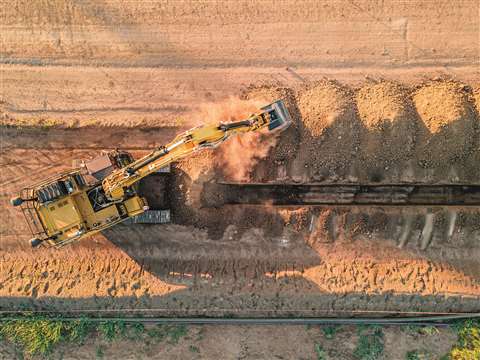 Built Robotics Exosystem at work (Photo: Built Robotics)
Built Robotics Exosystem at work (Photo: Built Robotics)
Over the past decade, the robotics industry has been developing numerous robotic solutions to automate processes and streamline projects.
US-based Canvas has developed a drywall finishing robot while Okibo’s robot provides painting and coating applications. Boston Dynamics, on the other hand, has led the way with more mobile robotics solutions – such as ‘Spot the Dog’ and their research-based humanoid robot ‘Atlas’.
What is a robot?
In construction terms, a robot is generally understood as a machine that operates autonomously, doing one specific (and usually repetitive) job.
Robots in construction have vast and varied roles with solutions that target pre-construction right through to adding the finishing touches to a project. Despite the possibilities robotics has, Erol Ahmed, director of communications at Built Robotics, believes that the definition of robots is often misconstrued when it comes to construction.
He says, “When we imagine robots, we think of human-like machines with the full set of capabilities of a person. When it comes to construction, robots really mean autonomy and assistive technologies that help skilled workers perform work safer, more productively, and more accurately.
“These can be small devices, custom-built machines, or aftermarket upgrades for existing equipment such as the Exosystem from Built Robotics. Robots take all shapes and forms.”
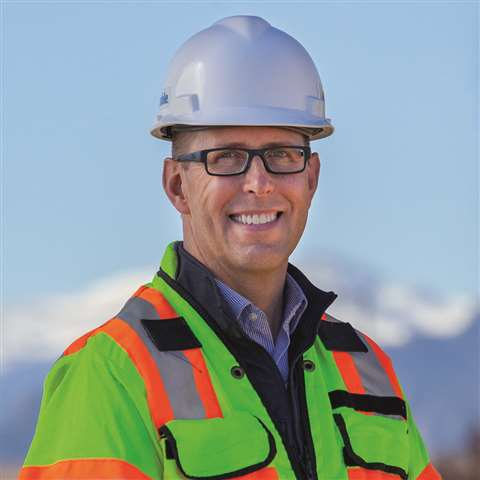 David Burczyk, construction robotics lead at Trimble (Photo: Trimble)
David Burczyk, construction robotics lead at Trimble (Photo: Trimble)
For David Burczyk, construction robotics lead at Trimble, a robot holds a somewhat similar meaning. Upon asking the question ‘how do you define what a robot is?’, Burczyk has to pause for a moment, despite the fact that he has been working in the industry for over ten years. This would seem to demonstrate that robotics has come a long way in the past few years alone and development shows no signs of slowing down.
“It’s interesting because we have our total stations and we refer to those as robotic total stations,” says Burczyk. “We took an approach where a traditional mechanical total station had two people operating it – so we had one person at the instrument and one with the layout stick – and those two were communicating back and forth to take their survey measurements. For us, that became a robot.
“We took a two-man job and turned it into one operator. It is not necessarily moving around with legs or wheels or anything of that nature, but it is acting in a robotic fashion where it becomes a co-worker on the job site.”
Both Ahmed and Burczyk agree that a ‘one size fits all’ approach to the definition of robotics in construction does not fully capture the magnitude of possibilities the technology holds.
Automating construction
Robotics can play a role in a variety of tasks on site but automation is what sets it apart from other technologies. Automating construction processes is something that we are beginning to see more and more of – especially in larger urban projects where time and money are obstacles. Automation has the potential to carry out injury-plaguing and risky tasks that construction workers must often face, thereby reducing worker fatalities.
Matthew Johnson-Roberson, director of the Robotics Institute at Carnegie Mellon University, sees the continued trend of automation on the cards for the future of robotics. He sees the technology developing for subtasks and more scalability in terms of reliability while decreasing costs.
Trimble’s Burczyk has been speaking with those on the ground and discovered that it’s about investing money into a product that can be used again and again that really adds value to a project. “What we’re hearing when talking to our customer base is that they really want to automate the processes. The general contractors that are using the laser scanners, they’re taking budgets that they already have, to document the construction with laser scanners.
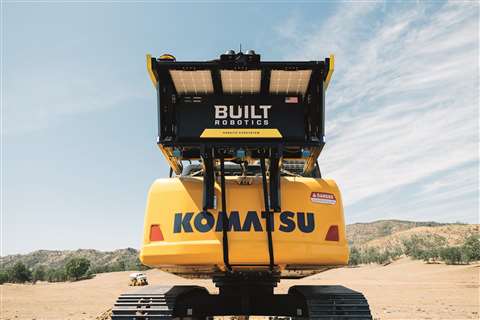
“Typically, in those applications today it gives them one opportunity to come to the job site, capture a scan and that’s it. By taking that same budget and investing it into robotics, they now have the ability to take the data from the very beginning of the project all the way through to the end of the project – captured as many times as they want. This is opening a whole new frontier for them to get some data analysis and have new insights into the project that they just didn’t have before.”
Market research company IDTechEx says that autonomous mobility is one of the most important parts of robot autonomy. With the increasing demand for autonomous solutions across a number of industries, including construction, the company concludes that autonomous mobility will have more unprecedented growth than ever.
Co-developing solutions
Back in October 2020, Trimble announced a strategic alliance with Boston Dynamics to co-develop a solution to bring robotics into the building and civil construction industry.
For collecting construction data on the job site, Trimble has three different payloads that they’re planning to focus on. The first one that the US-based company has come out to market with is reality capture – the Trimble X7 scanner is currently being used with Boston Dynamics ‘Spot the dog’ – with further plans for robotic total stations in the future.
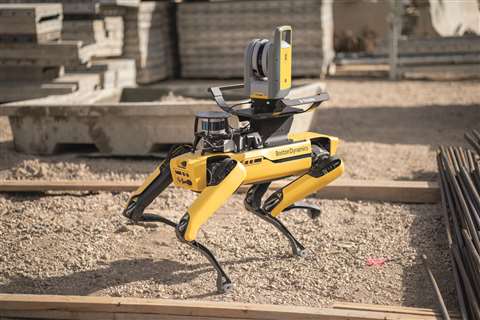 Trimble and Boston Dynamics collaboration (Photo: Trimble)
Trimble and Boston Dynamics collaboration (Photo: Trimble)
Trimble’s X7 Scanner is a terrestrial laser scanner, which goes from different positions or waypoints and captures AA360 laser scans from each of those waypoints.
Burczyk is one of the minds behind Trimble’s scanner collaboration with Spot. “With Spot you teach it a path or a mission that you want it to walk, and it can then run that mission autonomously, as many times as you want.
“Once you train it where to go, you’re telling it where it’s safe for it to operate and where the areas are that you want to collect. It is along that path that you define those waypoints and at each waypoint that’s where the laser scanner works.”
The laser scanner performs the same task over and over again while maintaining a consistent level of data collection – a role that is both repetitive and menial for skilled workers.
As robotics has made its way into the construction industry, there has been debate about whether this supports the skills shortage or encourages job losses.
Burczyk believes that it is a matter of collaboration. “When I first came on board, around 10 years ago, we introduced the robotic total stations on the job site. That was the first introduction of a robot into construction. There was a lot of fear at that time, that you were taking away jobs; then, as it got implemented into more workflows, people saw it as a collaborative piece and it wasn’t something that was replacing them.”
Johnson-Roberson of Carnegie Mellon University agrees with Burczyk, saying the introduction of robots onto the construction site will require teamwork. “I do think collaboration is critical. There isn’t any full system anywhere near ready to take over all construction elements.
“I tell workers to think about doing excavation without a backhoe [loader] or building tall buildings without cranes. It is unthinkable. I think the next generation of all those kinds of tools will be smarter and safer, in addition to reducing injury and improving efficiency, which will be positive for workers and developers.”
Identifying bottlenecks
Alongside the apprehension surrounding jobs, many are concerned that this could be the start of robots taking over entire projects. Built Robotics’ Ahmed is quick to debunk this myth.
“Instead of asking if robots would ever completely take over, we should instead ask do we need them to “take over?” The short answer is no,” he says.
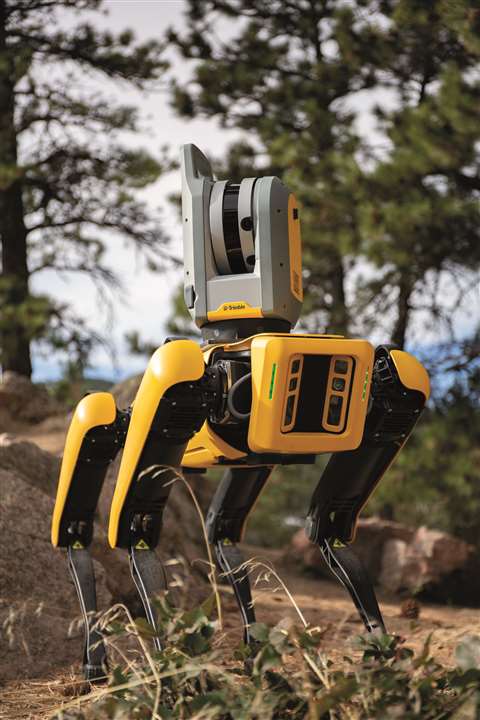 Boston Dynamics’ Spot Robot with Trimble X7 3D Scanning System (Photo: Trimble)
Boston Dynamics’ Spot Robot with Trimble X7 3D Scanning System (Photo: Trimble)
“We should create robots thoughtfully and in original ways, which is the approach the construction, mining, and agriculture industries have been taking. Instead of trying to recreate human behaviour, these industries have identified their biggest bottlenecks in terms of workforce, productivity, and hazards, and work from problem to solution. This way, we create robots that make sense and have immediate economic value while creating safer and more efficient jobsites.
“At the end of the day,” says Ahmed, “robots are tools in the hands of skilled workers, who ultimately decide how and when a robot makes sense.”
Robots in construction are proving to be effective tools that are being welcomed by workers and contractors. Built Robotics says they have trained skilled workers to become “Robotic Equipment Operators” (REOs). Ahmed adds that this keeps workers involved with the latest advancements in autonomy and allows them to manage Built Robotics’ robots on jobsites.
Ahmed highlights that by training and involving everyone in how robots are built and deployed, we can ensure people and machines work together in ways that grow the construction industry, which benefits everyone at all levels.
He says, “This approach allows us to overcome the common misconceptions about robotics and keeps us focused on practical, common-sense applications of advanced technologies – something that has and will continue to grow the construction sector.”
As Ahmed says, overcoming the misconceptions surrounding robotics in construction is a key starting point for their adoption in the future. Whilst some are apprehensive as to whether robotics is the way forward there are other companies in the industry that are making great strides in ensuring that they are a part of the future.
US-based manufacturer of lifting and material-handling Terex has recently bought into robotics company Apptronik with plans to co-create potential robotic applications for Terex products. The technology company specialises in the development of versatile, mobile robotic solutions.
Apptronik’s co-founders have worked on advanced human-centred systems including the NASA Valkyrie Robot for the DARPA Robotics Challenge. Other Apptronik projects include Astra, an upper-body humanoid robot packed into a small form, enabling it to be placed on any mobility platform and most recently, Apollo, a NASA-backed versatile humanoid designed to scale and apply to numerous applications.
As we continue to see more robotic solutions come to market there is hope that these could begin to solve some of the challenges that the construction industry face – be it the skills shortage or enhancing health and safety measures – and perhaps there will come a time where robotic solutions are just as instrumental in our projects as other pieces of equipment.
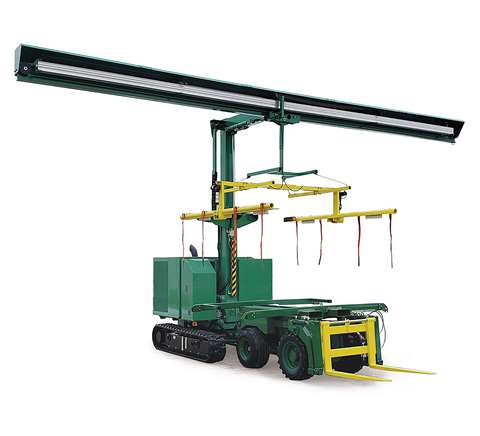
Solar panel installation robot, Solar Trax 824, is the first production robot in the field installing solar panels. The machine from Bailey Cranes can lift panels 8 inches high and traverse 24 inches to handle most Solar Field designs.
The company behind the robot says that the base machine is track driven, providing a high degree of traction and terrainability. Designed for rough terrains and increased slopes, the upper assembly is said to automatically level itself for increased stability and ease of panel placement.
The robot works via hydraulic functions that include Programmed Motion which combines multiple steps, such as “Raise-Left,” which raises the panels from the centre position, trolleys sideways to the support frame and lowers it in place.
Other functions include “Home,” which returns the tray to the centre position for reload and “Drive-Increment,” which drives the machine forward the exact distance for installation of the next 4 panels.
Bailey Cranes says that by incorporating vision systems from the autonomous vehicle industry allows the robot to precisely locate the solar panels onto the mounting structure.
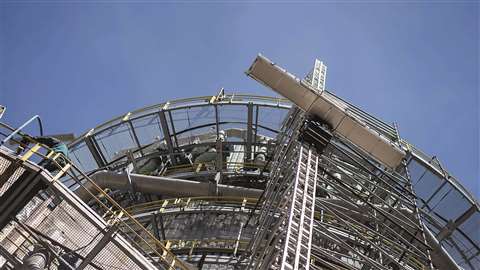
The Nemetschek Group, software providers for the construction and media industries, recently announced that they participated in a financing round for the robotics startup Kewazo.
The company says that Kewazo’s robotic products enable the automation and digitalization of the on-site material flow by combining robotics and data analytics. By being involved in critical on-site activities, the robotic products collect key operational data.
This data is then processed and provided to customers as actionable insights via the data analytics platform, enhancing the transparency of what happens on-site at construction sites and industrial plants.
“The investment by the global player Nemetschek is a big step forward for us. It closes the gap between onsite hardware and software, which is often only used in offices. It allows us to make the construction site more digital, smarter, and safer for everyone”, comments Artem Kuchukov, CEO and Co-Founder of Kewazo.





